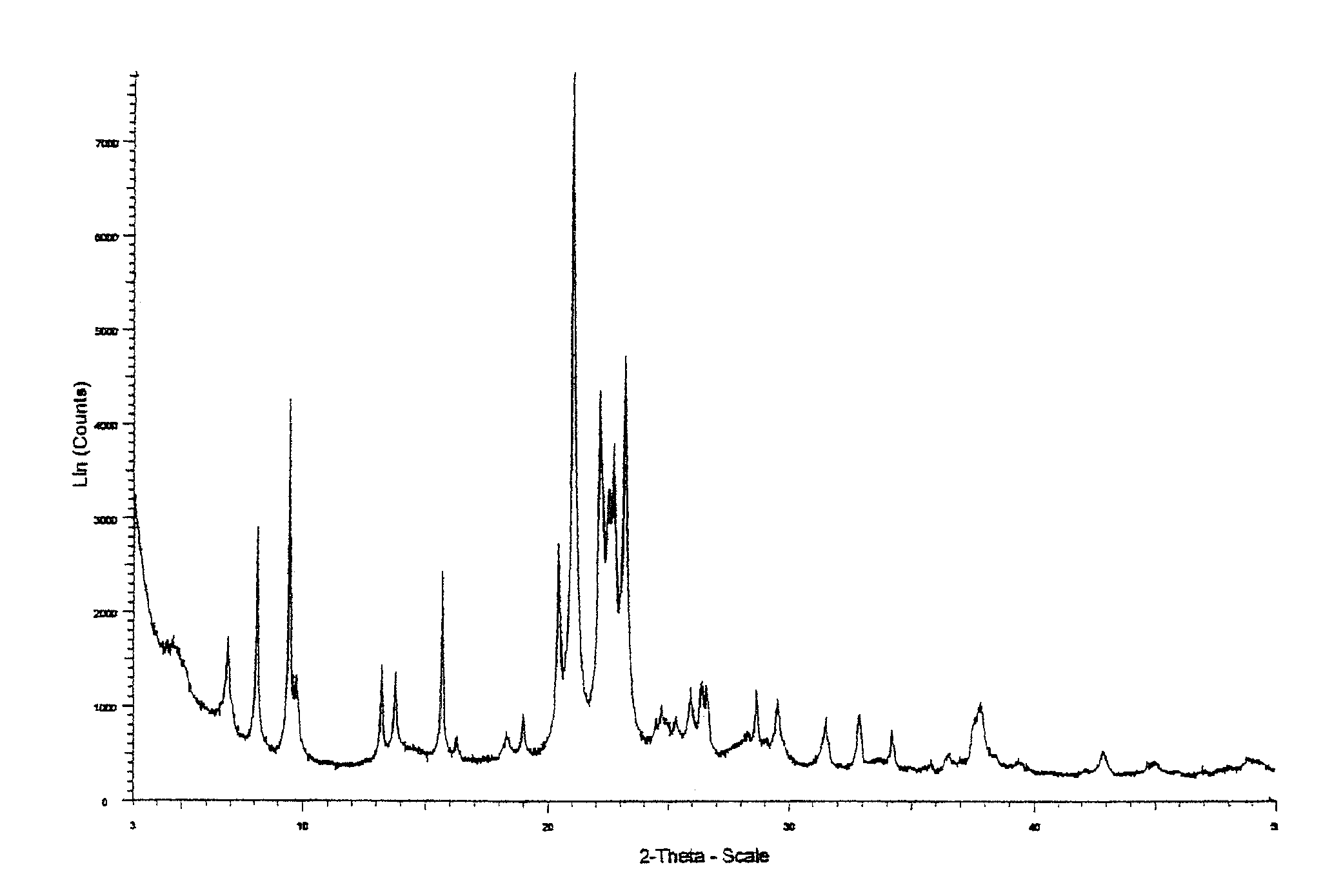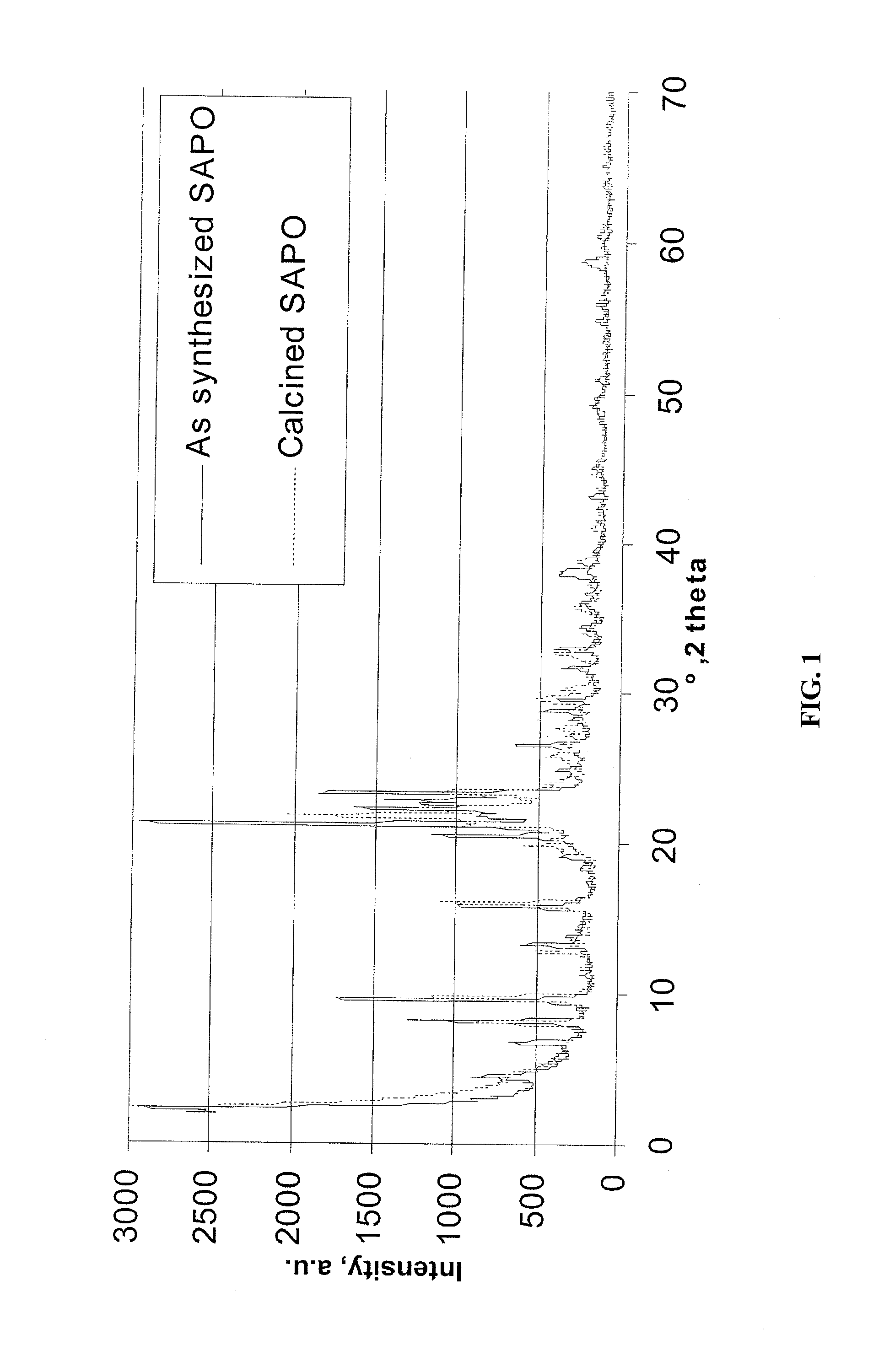Sapo molecular sieve catalysts and their preparation and uses
a molecular sieve and catalyst technology, applied in the field of sapo molecular sieve catalysts and their preparation and use, can solve the problems of unattractive environmental protection, high cost, and waste of resources, and achieve the effects of high raw material conversion, large reaction, and high efficiency
- Summary
- Abstract
- Description
- Claims
- Application Information
AI Technical Summary
Benefits of technology
Problems solved by technology
Method used
Image
Examples
example 1
Preparation of a Molecular Sieve Comprised of SAPO-11, Amorphous Phase, and SAPO-41
[0095]The following starting materials were used for the synthesis: pseudoboehmite (containing 74.67 wt % of Al2O3 and 25.33 wt % of water); orthophosphoric acid (85 wt % in water); 24.0 wt % SiO2 colloidal silica (with an average particle size of 200 nm and typical surface area of 80 g / m2); di-n-propylamine (DPA) as template; hexadecylamine (HDA) as surfactant additive, and distilled water as solvent. To prepare the synthesis gel the source of aluminum was firstly added to the distilled water at 50° C. for 1 hour; then the phosphoric acid solution was added in a 30-minute period to the alumina slurry and kept at 70° C. for 1 hour; then the colloidal silica was added in a period of 15 minutes and kept at 70° C. for 15 minutes, and finally a liquid mixture of the organics (DPA and HDA mixture at 70° C.) was added in 30 minutes to the synthesis mixture and kept at 70° C. for 1 hour. All steps were carri...
example 2
Preparation of a Molecular Sieve Catalyst in Extrudate and Pelletized Form
[0097]The calcined solid material from Example 1 was prepared as a catalyst in two different forms, viz,. (I) as an extrudate sample (containing 70 wt % of SAPO material), and (II) as a pelletized sample (containing 100% SAPO material).
[0098](I): The calcined powder was mixed with a peptised (with about 0.04-0.25 mol equivalent HNO3 acid to Al2O3) alumina hydroxide (binder) and water to a dough with a water content in the range of 38-48 wt %. The dough was extruded in cylindrical shaped extrudates with a diameter of 1.5 mm and an average length of about 3 mm. The extrudates were dried for 16 hours at 120° C., and were subsequently calcined for 1 hour in air at 550° C. The final support contained 30 wt % of the binder and 70 wt % of the SAPO product. The carrier was impregnated with a tetra-amine Pt(II) nitrate solution by a wet impregnation procedure. Finally, the extrudates were dried overnight at 110° C. fol...
example 3
Hydroisomerization of n-hexadecane Using Molecular Sieve of Example 1
[0100]In order to evaluate the effectiveness of molecular sieve produced as in Examples 1 and 2, several hydroisomerization reactions were carried out on a sample of n-hexadecane and representative samples of platinum-impregnated molecular sieve catalyst of this invention produced in Example 2. In order to achieve a comparative evaluation with highly advanced prior art SAPO-11 catalyst samples, i.e., samples 2-a and 2-b of U.S. Pat. No. 6,294,081, Example 2 and Table 4 thereof, preliminary experiments were carried out to determine whether the conversion level in reaction equipment available in our laboratories is stable at molar ratios above 5 moles of hydrogen per mole of the n-hexadecane. This determination was needed since Example 2 of the foregoing patent used a ratio of 50 moles of hydrogen per mole of hexadecane and in our laboratories it was not possible to perform a test at a molar hydrogen:hexadecane ratio...
PUM
| Property | Measurement | Unit |
|---|---|---|
| temperatures | aaaaa | aaaaa |
| temperatures | aaaaa | aaaaa |
| temperature | aaaaa | aaaaa |
Abstract
Description
Claims
Application Information
 Login to View More
Login to View More - R&D
- Intellectual Property
- Life Sciences
- Materials
- Tech Scout
- Unparalleled Data Quality
- Higher Quality Content
- 60% Fewer Hallucinations
Browse by: Latest US Patents, China's latest patents, Technical Efficacy Thesaurus, Application Domain, Technology Topic, Popular Technical Reports.
© 2025 PatSnap. All rights reserved.Legal|Privacy policy|Modern Slavery Act Transparency Statement|Sitemap|About US| Contact US: help@patsnap.com



